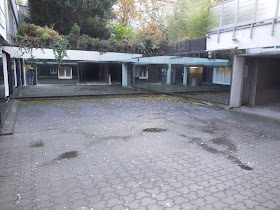Have you ever wondered what a Gestapo prison looked
like? At the NS Documentation Center of
the City of Cologne (in German, Köln), you can visit one in the basement of a building that was
the headquarters of the city and district Gestapo from 1935 until 1945. It has
ten cells that held prisoners brought in for what the Gestapo
called “intensive interrogations,” the Gestapo's preferred euphemism for torture.
In one of the ironies of war, despite intensive Allied
bombing of Cologne, the Gestapo's building survived with little damage, leaving,
according to the Documentation Center, “one of the best preserved detention
centers from the Nazi period in Germany.” The dark and squalid cells are
sobering enough by themselves, but the walls pack an emotional punch: on them are about 1,800 inscriptions left by the prisoners using
pencils, chalk, lipstick, nails, screws, and fingernails.
These inscriptions bring home the sober realization that
thousands of people were tortured in this basement. The prisoners were not
only Germans, but included many men and women brought from Eastern Europe and
Russia to be slave laborers. Of the 1,800 inscriptions, about 600 are written
in Cyrillic. The inscriptions include messages of desperation, despair,
frustration, and anger. Some were written just to tell people the writer had
been there, maybe hoping someone would read it and let their friends and
relatives know.
From the cellar cells, a passage leads to the inside courtyard.
According to the Documentation Center, this courtyard is where executions were
carried out. There, during the eighteen months of the war, about 400 prisoners
were murdered.
The Gestapo Prison Memorial was first opened in 1981. In
1988, the NS Documentation Center moved into the building. In addition to the prison museum, the Center has a permanent exhibit “Cologne during National
Socialism” and it also hosts shorter-term special exhibits. When I was there in
late October, the special exhibit was on Hitler Youth. The nicely-designed exhibit
examined the rise of Hitler Youth and its activities. One of its features was interviews
with several older men and women who had been members of Hitler Youth
describing why they joined the organization and its roles in family, school, leisure and other aspects of life.. The
exhibit’s photographs and artifacts are titled in both German and English, but
the interviews are only in German.
 |
| Part of the Hitler Youth Exhibit. To the left is a post about HJ advertising to the right is propaganda on "Race Types" used in school |
 |
| Poster for Hitler Youth special exhibition |
 |
| One purpose of Hitler Youth was to prepare young men to be dedicated and disciplined solders; this poster "We all pitch in" was intended to urge HJ members to take part in the war effort |
The Center has a large research library and offers numerous lectures and discussions. Also, it has an excellent website, including a 360-degree
tour that offers visitors a chance to travel around the center and see its
exhibits as well as the prison. The website is available in many languages,
including English. Go to http://www.museenkoeln.de/ns-dokumentationszentrum/pages/315.aspx?s=315
With its exhibits, well-preserved Gestapo prison, library, active
research program, and lectures, the Center appears to be an excellent resource
for educating people, Germans and visitors, on the horrors of the Nazi period.



No comments:
Post a Comment